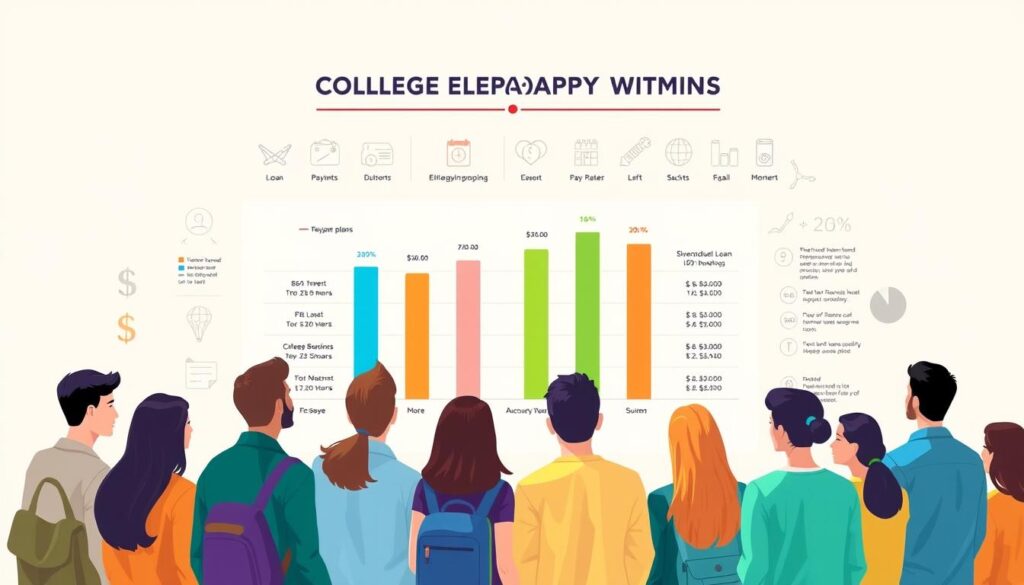Discover the Best College Loan Choices for Students
Nearly 70% of students need financial help to go to college. Tuition costs are high, making it hard for students to pay without aid.
We know how important financial aid for college is. There are many options, like federal and private student loans. Each has its own good points and things to think about.
Exploring college loans is key. It’s important to know the differences between them. This helps you make a smart choice.
Key Takeaways
- Understanding the types of financial aid available is crucial.
- Students have various options, including federal and private loans.
- Each loan type has its benefits and considerations.
- Choosing the right loan can significantly impact your financial future.
- It’s essential to consider your financial situation and goals.
Understanding College Loans and Their Importance
Going to college often means facing financial challenges. College loans help overcome these hurdles. It’s important to know how college loans work.
What are College Loans?
College loans are financial help for students to pay for college. They can come from the government, private lenders, or both. Understanding the types of loans available is key to making smart financial choices.
There are many types of college loans. These include Federal Direct Subsidized Loans, Federal Direct Unsubsidized Loans, and Federal Perkins Loans. Each has its own rules and benefits.
Why College Loans Matter for Finance
College loans are important for finance because they let students invest in their education. This can lead to better jobs and higher pay later. But, managing these loans well is crucial to avoid debt problems.
- They help pay for tuition and living costs.
- They offer loan repayment options for different financial situations.
- Managing them well can affect your credit score.
How College Loans Affect Future Earnings
College loans can affect your future earnings. The debt from these loans can be big, but the education can lead to better-paying jobs. This can help pay off the debt over time.
Research shows that college graduates often earn more than those without a degree. But, the type of degree and field can make a big difference.
- Picking a field with good job prospects helps repay loans.
- Knowing your loan terms, like interest rates and repayment, is important.
- Creating a budget for loan repayment helps manage debt.
Types of College Loans Available to Students
Students have many college loan options to choose from. It’s important to know about these options to make the right choice for your education.
Federal Student Loans
Federal student loans are a top pick for many students. They come with good terms and government support. These loans have lower interest rates and flexible repayment plans compared to private loans.
There are two main types: subsidized and unsubsidized loans. Subsidized loans are for those who need financial help, and the government covers the interest while you’re in school. Unsubsidized loans don’t rely on need, and you pay the interest from the start.
The U.S. Department of Education says federal student loans have many benefits. These include low fixed interest rates and income-driven repayment plans. This makes them a great choice for many students.
Private Student Loans
Private student loans come from banks, credit unions, and other lenders. They help cover costs not covered by federal aid. These loans often have variable interest rates and may need a credit check or cosigner.
Lenders like Ascent, Earnest, and College Ave offer competitive private student loans. It’s important to look at the terms and conditions before choosing a private loan.
Private loans are good for students who’ve used up their federal loan options or need more money. But, it’s key to know they usually have less favorable terms than federal loans.
Parent PLUS Loans
Parent PLUS Loans are federal loans for parents of dependent undergraduate students. They help pay for education costs. These loans are not based on need but require a credit check.
The loan amount can be up to the total cost of attendance minus other financial aid. Parent PLUS Loans have a fixed interest rate and offer flexible repayment options. This makes them a good choice for families.
The College Board says Parent PLUS Loans can be a valuable resource for families. But, parents should understand the loan terms and their financial situation before borrowing.
The Application Process for College Loans
Applying for college loans is a big step towards making higher education more accessible. We’re here to guide you through it. The process has several key steps. These steps, when followed correctly, can make getting financial aid for college easier.
Pre-Application Checklist
Before you start, it’s important to prepare. Here’s a checklist to help you get ready:
- Gather necessary documents like tax returns and social security numbers.
- Check your credit report if you’re looking at private loans.
- Research and understand the different types of loans available.
- Know the loan repayment options and college loan interest rates for each loan.
Filling Out the FAFSA
The Free Application for Federal Student Aid (FAFSA) is a key step. It shows if you’re eligible for federal, state, and school financial aid. To fill out the FAFSA:
- Go to the official FAFSA website.
- Create an FSA ID if you don’t have one.
- Enter your personal and financial info accurately.
- List the schools you’re applying to.
- Submit your application and check your Student Aid Report (SAR).
Tips for a Smooth Application
To make the application process smoother, consider these tips:
- Apply early to meet deadlines.
- Be thorough and accurate when filling out forms.
- Keep track of your application’s status.
- Don’t hesitate to reach out to your school’s financial aid office for help.
By following these steps and tips, you can confidently navigate the college loan application process. This will help you secure the financial aid you need for success.
Interest Rates Explained
Interest rates are key in figuring out the cost of a college loan. Knowing how they work is important for handling your debt well.
Fixed vs. Variable Interest Rates
When you get a college loan, you must pick between fixed and variable rates. Fixed interest rates stay the same, so your monthly payments are always the same. Variable interest rates can change with the market, which might alter your monthly payments.
Choosing between fixed and variable rates depends on your financial situation and how much risk you’re willing to take. For example, if interest rates are going up, a fixed-rate loan might be better. But if rates are falling, a variable-rate loan could save you money.
Current Interest Rate Trends
It’s important to stay updated on interest rate trends for your college loan. In recent years, rates for federal student loans have been low, which is good for borrowing.
But, watching economic signs and policy changes is crucial. The Federal Reserve’s moves can change student loan interest rates.
“The interest rate on your student loan can significantly affect your monthly payments and the total amount you repay over the life of the loan.”
How Interest Rates Impact Repayment
The interest rate on your college loan affects how much you’ll pay back. A higher rate means you’ll pay more over time. For example, a loan with a higher rate will gain more interest, making the total cost higher.
| Loan Amount | Interest Rate | Total Repayment |
|---|---|---|
| $10,000 | 4% | $11,971 |
| $10,000 | 6% | $12,994 |
Knowing how interest rates affect your loan repayment is key for planning your finances. Looking into loan repayment options and student loan refinancing can help manage your debt better.
Federal Student Loans: A Closer Look
Federal student loans help students reach their academic goals without financial stress. These loans are from the federal government. They offer good interest rates and flexible repayment plans.
Subsidized vs. Unsubsidized Loans
There’s a big difference between subsidized and unsubsidized loans. Subsidized loans are for those who really need them. The government pays the interest while you’re in school and during certain periods. Unsubsidized loans start accruing interest right away. You have to pay this interest yourself.
Subsidized loans have big benefits:
- They cost less because the government covers interest in certain times
- They help reduce your financial load while you’re in school and during grace periods
Unsubsidized loans offer:
- More flexibility for students who don’t qualify for subsidized loans
- The chance to borrow more money for school expenses
Loan Limits for Federal Loans
Federal student loans have limits based on your school year and if you’re dependent. Knowing these limits helps plan your finances well. Dependent students usually have lower limits than independent students.
Here are some important loan limit points:
- Undergraduate students can borrow from $5,500 to $12,500 each year.
- There are total limits on how much you can borrow over your college career.
- Grad students can borrow more than undergrads.
Repayment Options Available
Federal student loans offer many repayment plans. These include Standard Repayment Plans, Graduated Repayment Plans, and Income-Driven Repayment (IDR) Plans. IDR plans, like Income-Based Repayment (IBR) and Pay As You Earn (PAYE), can lower your payments based on your income and family size.
These repayment options have benefits:
- They let you manage your payments better
- They offer loan forgiveness after a set number of payments under IDR plans
It’s key to look at these options and pick the one that fits your finances best.
Private Student Loans: Pros and Cons
Understanding private student loans is key to making smart choices. It’s important to know their pros and cons.
Private loans come from banks, credit unions, and online lenders. They help students pay for school when federal loans aren’t enough.
When to Consider Private Loans
Think about private loans when you’ve hit federal loan limits. Or if you need flexible repayment plans. It’s crucial to weigh the pros and cons first.
Some good things about private loans include:
- Potential for lower interest rates for borrowers with good credit
- Flexible repayment terms
- No subsidy requirements
But, there are downsides too:
- Higher interest rates for borrowers with poor credit
- Less flexible repayment options compared to federal loans in some cases
- No borrower benefits like loan forgiveness or income-driven repayment
For more detailed information on the pros and cons of private student loans, visit Bankrate.
How to Choose a Lender
Choosing the right lender for a private student loan is important. Compare rates, terms, and benefits. Consider the following factors:
| Lender | Interest Rate | Repayment Terms | Borrower Benefits |
|---|---|---|---|
| Ascent | Variable: 4.52% – 12.64% | 5-15 years | No origination fees, career support |
| Earnest | Variable: 3.74% – 9.74% | 5-15 years | No origination fees, flexible payment options |
| College Ave | Variable: 4.29% – 12.99% | 5-10 years | No origination fees, autopay discount |

Understanding Loan Terms and Conditions
It’s vital to understand your private student loan’s terms and conditions. Look at the interest rate, repayment terms, and any fees.
Read the loan agreement carefully before signing. This helps avoid surprises during repayment.
Managing Your College Loan Debt
Understanding your loan options and budgeting are key to managing college loan debt. It’s a vital part of financial planning for students after graduation.
Creating a Budget for Repayment
Creating a budget is the first step in managing your college loan debt. It means knowing your income, expenses, and debt. We suggest spending 50% of your income on necessary expenses, 30% on discretionary spending, and 20% on saving and debt repayment.
To begin, track your income and expenses. This helps you see where your money goes. Then, find ways to cut back and use that money for your debt.
Strategies for Loan Repayment
There are several ways to pay off your loans. The snowball method pays off loans with the smallest balances first. The avalanche method targets loans with the highest interest rates.
Let’s look at these strategies:
| Repayment Strategy | Description | Benefits |
|---|---|---|
| Snowball Method | Pay off loans with the smallest balances first | Quick wins, reduced number of loans |
| Avalanche Method | Pay off loans with the highest interest rates first | Saves money on interest over time |
| Income-Driven Repayment | Payments based on income and family size | Lower monthly payments, potential for loan forgiveness |
Importance of Staying Informed
It’s important to know about your loan options, interest rates, and repayment terms. This knowledge helps you make smart decisions about your debt. You might save money by refinancing or consolidating your loans.
Always check your loan statements and stay up-to-date on any changes to your loan terms or repayment options.
Repayment Plans and Options
Managing college loan debt is easier when you know your repayment options. The right plan can help you pay off your debt faster and save on interest.
Standard Repayment Plan
The Standard Repayment Plan is the default for federal student loans. It has fixed monthly payments for 10 years. This plan is good for those who want to pay off their loans quickly.
Key Features: Fixed monthly payments, repayment term of 10 years.
Income-Driven Repayment Plans
Income-Driven Repayment (IDR) plans adjust your payments based on your income and family size. There are several IDR plans, like Income-Based Repayment (IBR), Pay As You Earn (PAYE), and Revised Pay As You Earn (REPAYE).
Benefits: Lower monthly payments, potential for loan forgiveness after 20 or 25 years of qualifying payments.
Loan Forgiveness Programs
Loan forgiveness programs can wipe out part or all of your student loan debt. The most well-known programs are Public Service Loan Forgiveness (PSLF) and Teacher Loan Forgiveness.
| Program | Eligibility | Forgiveness Amount |
|---|---|---|
| Public Service Loan Forgiveness (PSLF) | Working in public service, 120 qualifying payments | Remaining balance after 120 payments |
| Teacher Loan Forgiveness | Teaching in low-income schools, 5 years of service | Up to $17,500 |

Common Mistakes to Avoid with College Loans
Understanding college loans is complex. Knowing common mistakes can help avoid financial trouble. This knowledge is key for students and their families to manage debt wisely.
Not Reading the Fine Print
Many borrowers miss out on important details in their loan agreements. This can lead to surprises like higher interest rates or stricter repayment terms. It’s crucial to carefully review all loan documents before signing.
Knowing your loan repayment options is also important. There are different plans, like income-driven repayment, that can change your financial situation after graduation.
Overborrowing: How to Avoid It
Overborrowing can cause a lot of debt. Students often borrow more than they need, without thinking about the future. To avoid this, create a realistic budget for all your education costs. This way, you’ll know exactly how much to borrow.
It’s also important to understand college loan interest rates. Different rates can change how much you pay over time. Comparing rates can help you get a better deal.
Missing Payments and Consequences
Missing loan payments can hurt your credit score and lead to legal trouble. To avoid this, stay organized and keep track of your payment schedules. Automatic payments can also prevent missed payments.
If you’re having trouble with payments, look into loan repayment options like deferment or forbearance. Financial aid counselors can also offer advice on managing college debt effectively.
Resources for College Loan Borrowers
Managing college loan debt needs the right tools and info. Several key resources are available. Knowing where to get help is key in the complex world of college loans.
Financial Aid Offices
The financial aid office at your college or university is a top resource. They guide on loan options, help with applications, and offer debt management advice. Financial aid offices are a valuable resource for students and parents, offering personalized help.
It’s important to keep in touch with your financial aid office. They can inform you about loan forgiveness, repayment options, and other help.
Online Loan Calculators
Online loan calculators are a must-have for managing college loan debt. They let you estimate monthly payments, total loan costs, and compare repayment plans. Using an online loan calculator can help borrowers make informed decisions about their loans.
By entering your loan details, you can explore different repayment scenarios. This includes income-driven plans, to find the best fit for your finances.
Nonprofit Credit Counseling Services
Nonprofit credit counseling services offer expert advice on debt management. They cover various financial topics, including loan repayment and credit management.
Working with a nonprofit credit counselor can help you create a plan to pay off loans efficiently. These services are often free or low-cost, making them accessible for those struggling with debt.
By using these resources—financial aid offices, online loan calculators, and nonprofit credit counseling services—borrowers can manage their college loan debt better. This helps achieve financial stability.
Tips for Future College Students on Loans
Understanding student loans is key in today’s college world. With $870 billion in student loan debt, many students struggle with their finances. It’s important to know how to handle this debt.
We suggest starting early to learn about college loans. Look into federal, private loans, and financial aid. This way, you can manage your finances better.
Research and Planning
Understanding different college loans is crucial. Know their interest rates and repayment terms. This knowledge helps you make smart financial choices.
Exploring Financial Avenues
It’s important to consider all your options. This includes federal loans, private loans, and scholarships. Knowing the benefits and drawbacks of each helps you plan your finances well.
Seeking Help
Don’t be afraid to ask for help with student loans. Financial aid offices, online tools, and credit counseling services can be very helpful.









